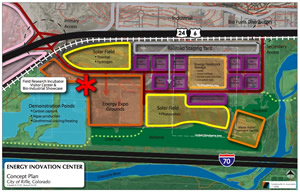
- Recent town of Vail community survey identifies parking as top issue for townies
- Vail Christian High School board buys back bonds, rescues next school year
- Vail Resorts to host Lindsey Vonn celebration in Vail Wednesday, March 31
- Vail Resorts Epic Pass, Summit Pass available through November 30, 2009
- 9 candidates, including 3 incumbents, running for 4 Vail Town Council seats Nov. 3
- Nominating petitions for four open Vail Town Council seats available Sept. 14
- Eagle County commissioners to vote Tuesday on temporary marijuana dispensary regulations
- Vail Town Council rejects ballot question to change council terms
- Polis defends health-care reform at packed town hall in Edwards
- Vail blaze illustrates need for defensible space, roadless rule changes, state says
- All Real News Articles
May 11, 2009 — Rifle Mayor Keith Lambert, in an effort to offset the ups and downs of the fossil fuel industry, is offering free or very cheap city-owned land to renewable energy companies interested in relocating to the Western Slope natural-gas capital.
While natural-gas production in surrounding Garfield County is expected to be off anywhere between 60 and 80 percent by this summer, Lambert and other town officials see Colorado Gov. Bill Ritter’s “New Energy Economy” continuing to expand, especially given the state’s ongoing beetle-kill epidemic and the potential for biomass.
Located on a large chunk of 200 acres of city land west of town, Rifle’s Energy Innovation Center currently houses part of the town’s 2.3-megawatt solar array that powers a wastewater treatment plant and a pumping station. It’s the largest municipal array in the state, but Lambert wants to see private companies locate there as well.
“There are companies we’re in contact with right now who are in the renewable sector who are interested in relocating to the city of Rifle because of what we’re doing and because of what the overall direction of the city is,” Lambert said, specifically mentioning biomass.
“If there are other companies that are interested that fit that criteria and they want to relocate here, we could put some land under them and help to accomplish their goals and at the same time help to accomplish our goals,” he added.
Last month, U.S. Sen. Mark Udall toured the site and lauded local efforts to diversify the energy economy, saying rural America, with high unemployment and therefore a ready-made workforce, will play a key role in remaking the nation’s energy infrastructure.
Lambert also pointed out that Rifle’s location along Interstate 70 and lower real estate costs— relative to other mountain towns — make it ideal for such a venture.
“The other thing we have going for us that’s really a plus is we have a rail line going right through this property and the ability to bring in these raw materials and utilize them for renewable purposes,” Lambert said, again referring to a possible biomass plant.
Rifle is surrounded by national forests infested with mountain pine beetles that have killed millions of acres of lodgepole pine trees that will either be consumed by massive wildfires or topple and rot. Either way, government studies show Western forests will eventually spew more carbon dioxide than they absorb, actually contributing to global warming.
A growing movement to utilize existing wood gasification biomass power-plant technology that converts wood products into thermal energy or electricity has been stymied by the costs of building such facilities, the inability to secure contracts to remove the wood from federal lands and the high cost of real estate in mountain towns.
“So the technology’s there,” said Holy Cross Energy CEO Del Worley, whose electric co-op stretches from Aspen to Vail and includes Rifle. “A lot of it’s cost right now and getting the wood. Probably more of a consideration is could you actually get one sited in Vail or Avon just because of real estate. Now, could I build one down by Rifle and would it work? Sure, in a heart beat.”
Talk of reworking National Environmental Policy Act rules governing timber sales on federal lands to allow for lower costs and more efficient removal of beetle-killed wood has met with resistance from environmentalists, some of whom say nature should play its course and forests should be allowed to burn.
Others in the conservation community are more pragmatic, saying high-value areas such as ski areas and mountain towns should be protected through major thinning projects. But even then, more aggressive harvesting of the forests farther from towns remains a sticking point.
“In order to finance [a biomass plant] you need probably a minimum of 15-year fuel supply,” Worley said. “Even after you get some of [the beetle kill] out, what Colorado hasn’t had for a long time is real forest management, so after you plant new ones you’ve got to go in and thin them and you could chip that slash up so there’s plenty of supply if you can just figure out how to get it on a fairly long-term contract.”
Critics of a comprehensive federal energy bill that calls for a renewable energy standard of 25 percent by the year 2025 say the massive biomass potential of the nation’s diseased and dying national forests is largely ignored in the legislation introduced in late March.
![]() Comment on "Rifle renewable energy campus could be part of Vail, Avon's biomass solution" using the form below
Comment on "Rifle renewable energy campus could be part of Vail, Avon's biomass solution" using the form below












